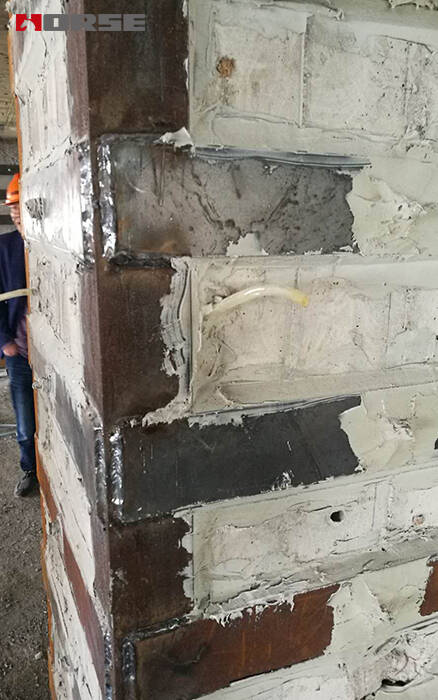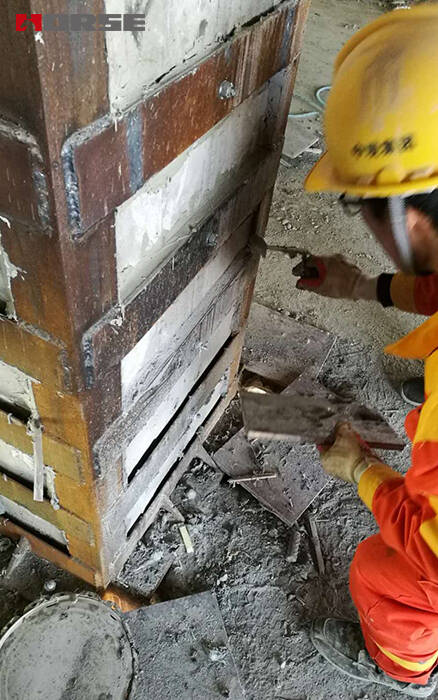Building strengthening after fire
Epoxy bonded steel plate and steel jacketing
The third beam is reinforced with external sticky steel plate, and the second storey column knocks off the surface plastering, and after the steel jacketing reinforcement, it is repainted.

Project overview
Brick and concrete structure, the one or two floor is reinforced concrete frame structure, as a commercial facade. The three - eight floor is a house. The precast concrete hollow slab is adopted for the floors. The masonry of the residential building is constructed with Mu15 brick and M10 mortar. The strength of the bottom two story frame concrete is C30. The fire began at 3:30 in the morning of August 27, 2008. The fire started at the front of the floor, then quickly spread to the back half of the whole floor, and melted some glass and aluminum alloy windows, but did not burn the third floor. The fire burned for 100 minutes until the fire was controlled at 5:10.
Structural damage and analysis
Because the combustion occurred on the second floor, the damage of the three floors of the beam slab and the second layer column was very obvious. The ash layer on the column generally cracked and peeling off, and the concrete protective layer of some columns cracked, and the burn degree of individual columns reached 50mm. The third layers of the beam bottom are generally burnt out, the damage of the bottom of the beam is the most serious, the side of the beam side burning crisp is lighter than the bottom, but there is a large area of cracks and cracks, the cracks are removed, and a few cracks go deep into the core concrete of the beam. Some of the beams were severely burned and their stiffness was significantly reduced. The second floor slab is generally good. The concrete burning crisp in the bottom of the third floor slab is widely shedding, most of the hollow slab holes are exposed, and the prestressed reinforcement of the hollow slab appears to be exposed and relaxed in large area, which makes the hollow plate lose its bearing capacity.
Structural strengthening scheme
The general idea of strengthening is:
First of all, steel pipe support is adopted for third storey floor beams to exclude danger. The third floor slab, which is too serious, decides to be demolished and re cast concrete plate. The third beam is reinforced with external sticky steel plate, and the second storey column knocks off the surface plastering, and after the steel jacketing reinforcement, it is repainted.

Column reinforcement
Because the column surface has been damaged, the column cross section is weakened greatly, and the outer steel is used to reinforce it. This method can increase the bearing capacity of column section and increase the bearing capacity of the column because of the lateral restraining effect of the new steel hoop, so that the original concrete column is in a good three direction stress state.
Beam reinforcement
The damage of beam side and beam bottom is more serious, and the strength decreases greatly, so choose steel plate to strengthening the beam.
In this method, a high strength steel plate is attached to the reinforced concrete beam of the reinforced concrete beam. It can not only ensure the concrete and steel plate as a new integral force, but also give full play to the bending, shear and compressive properties of the steel members. As the concrete surface is loose and spalling after fire, it should be removed before it can be reinforced. After the damaged concrete is removed, the surface of the concrete will be uneven. It can be leveled by the mortar and mortar, and then the steel can be strengthened by sticking steel.
Slab reinforcement
The third floor slab is the most serious damage component, its surface concrete large area fall off, the steel bar is exposed, some steel has been rusted and broken, it is decided to dismantle the original concrete hollow floor and pour the reinforced concrete slab. And the floor is the transfer story between the frame and the brick part. The overall cast-in-situ is beneficial to the rigidity of the building.